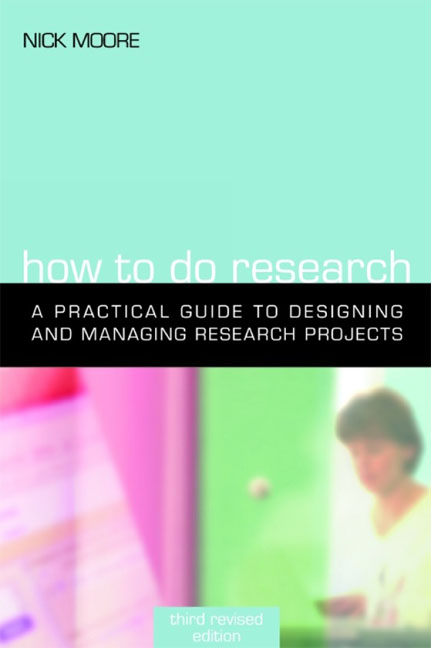Book contents
- Frontmatter
- Contents
- Acknowledgements
- Introduction: Types of research
- Part 1 The research process
- 1 Develop the research objectives
- 2 Design and plan the study
- 3 Write the proposal
- 4 Obtain financial support for the research
- 5 Manage the research
- 6 Draw conclusions and make recommendations
- 7 Write the report
- 8 Disseminate the results
- Part 2 Methods
- Appendix The market for information professionals: A proposal from the Policy Studies Institute
- Index
3 - Write the proposal
from Part 1 - The research process
Published online by Cambridge University Press: 09 June 2018
- Frontmatter
- Contents
- Acknowledgements
- Introduction: Types of research
- Part 1 The research process
- 1 Develop the research objectives
- 2 Design and plan the study
- 3 Write the proposal
- 4 Obtain financial support for the research
- 5 Manage the research
- 6 Draw conclusions and make recommendations
- 7 Write the report
- 8 Disseminate the results
- Part 2 Methods
- Appendix The market for information professionals: A proposal from the Policy Studies Institute
- Index
Summary
Just as a builder requires a detailed set of plans to guide the building of a house, so a researcher needs a proposal to help structure and manage the research project. Too often, the proposal is regarded as an inconvenience that is only required in order to obtain external funds for a project or to obtain approval for an academic dissertation. It is thought to be something that can be discarded once the funds have been allocated or the approval given. This is a very limited view of research proposals. Those who take it leave themselves without one of the most useful tools for managing research.
Research proposals, in fact, play a number of important rôles in the research process and, while preparing a proposal may seem like a distraction or an unnecessary waste of time, the work involved should ensure that you think through all the aspects concerned with the project before the research itself begins to take over. Because once the project starts rolling it is often too late to begin making changes and adjustments that would have been obvious in advance if the project had been properly prepared.
The purposes of research proposals
Proposals have a number of different purposes. A small in-house project will clearly require a less complicated proposal than a major project for which external funds are being sought. But the purposes they serve will, by and large, be the same.
To gain the approval of a supervisor
The proposal plays an important rôle in justifying the research to a supervisor. It is the vehicle that you use to argue the case for the research, demonstrating that it is important that you are capable of undertaking – and successfully completing – the work, and that the work will enable you to achieve the educational objectives of the exercise.
For academic research projects, you will need to obtain your supervisor's approval for your ideas at an early stage. You will need to be able to show that you have a clear understanding of the general issues and theories associated with the topic that you wish to study. You should be able to cite the key authors in the field and you should be able to demonstrate how your approach fits with the research that others have carried out.
Information
- Type
- Chapter
- Information
- How to Do ResearchA practical guide to designing and managing research projects, pp. 30 - 44Publisher: FacetPrint publication year: 2006
